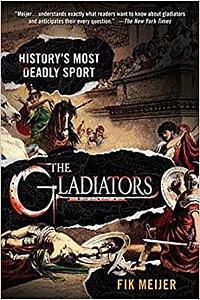Take a photo of a barcode or cover
A little bit dry, sort of academic and wonky, nevertheless a thorough examination of the cultural phenomenon which has inspired so much after it: the gladiatorial combat. Detail-heavy and well-documented, but not super-entertaining (as a good historical text rarely is). 8/10.
I learned alot from this book. Definitely not always an enjoyable read because of the content though. I would caution most parents to preread this book in it's entirety. It was very well organized and moved along at a quick enough pace from topic to topic, and was a good overview of the gladiators and the Roman culture that thrived on violent "entertainment."
informative
medium-paced
dark
informative
fast-paced
Plot or Character Driven:
N/A
Strong character development:
N/A
Loveable characters:
N/A
Diverse cast of characters:
N/A
Flaws of characters a main focus:
N/A
4.25*
Audioboek op Storytel.
Echt een heel leerrijke en ontzettend leuke, interessante non-fictie! Zeker een aanrader!
Audioboek op Storytel.
Echt een heel leerrijke en ontzettend leuke, interessante non-fictie! Zeker een aanrader!
informative
fast-paced
Plot or Character Driven:
Plot
informative
fast-paced
A thraex fighting a retiarius? No Mister Kubrick!
I bought this a few years ago in a museum shop and I recently found it again. This an interesting little book. It is engaging and easy to read, but at the same time well-researched and honest. Fik Meijer gives references for all his findings, but they never intrude on the flow of reading and he’s not afraid to say ‘let’s be honest, we just don’t know’. Besides giving us the historical facts and evidence he also cleverly points out that there is danger in seeing history through our modern eyes, with our modern ideas about violence and animal cruelty. Ancient Rome was a violent place to grow up in and let’s face it, we too love watching violence. Watching a Tarantino movie on TV is just easier than sitting on a stone arena bench for a whole day ( I tried it for 5 hours watching an opera and even with a cushion it’s quite painful).
In just over 200 pages Meijer treats the origin of the gladiator fights, the backgrounds of the gladiators, the weapons used, daily life, food, private life, the political significance, the influence of the rise of Christendom and the demise of this form of entertainment. Through his description of a typical day at the Colosseum you get a pretty good idea of how things worked during festivities. He does not forget to include how to get tickets and what to do with all the corpses and cadavers.
As most of our ideas about gladiators are formed by films such as Kubrick’s Spartacus and Ridley Scott’s Gladiator, Fik Meijer finishes by briefly analysing these with respect to the gladiator fights, weapons used and historical context. This last chapter is in no way a sour historian’s movie bashing, but it casually informs us of the accuracies and inaccuracies and whether they’re really all that important.
I bought this a few years ago in a museum shop and I recently found it again. This an interesting little book. It is engaging and easy to read, but at the same time well-researched and honest. Fik Meijer gives references for all his findings, but they never intrude on the flow of reading and he’s not afraid to say ‘let’s be honest, we just don’t know’. Besides giving us the historical facts and evidence he also cleverly points out that there is danger in seeing history through our modern eyes, with our modern ideas about violence and animal cruelty. Ancient Rome was a violent place to grow up in and let’s face it, we too love watching violence. Watching a Tarantino movie on TV is just easier than sitting on a stone arena bench for a whole day ( I tried it for 5 hours watching an opera and even with a cushion it’s quite painful).
In just over 200 pages Meijer treats the origin of the gladiator fights, the backgrounds of the gladiators, the weapons used, daily life, food, private life, the political significance, the influence of the rise of Christendom and the demise of this form of entertainment. Through his description of a typical day at the Colosseum you get a pretty good idea of how things worked during festivities. He does not forget to include how to get tickets and what to do with all the corpses and cadavers.
As most of our ideas about gladiators are formed by films such as Kubrick’s Spartacus and Ridley Scott’s Gladiator, Fik Meijer finishes by briefly analysing these with respect to the gladiator fights, weapons used and historical context. This last chapter is in no way a sour historian’s movie bashing, but it casually informs us of the accuracies and inaccuracies and whether they’re really all that important.
Todenmukaisesti kirjoitettu kirja gladiaattoreiden historiasta. Kirjailija pystyy epäilemään kantaansa ja kritisoimaan lähteitään ja silti kirja jaksaa pitää otteessaan loppuun saakka. Suosittelen niille, jotka ovat kiinnostuneita sen ajan historiasta.




